It’s autumn, in Edmonton. A crowd begins to gather outside an enclosed asphalt rink where bodies will soon be pressed against each other. It’s freezing; mittened hands wrap around paper cups for warmth (coffee, hot chocolate, insulated liquor) and the air vibrates. Depending on why they’ve come, people display eagerness, curiosity, or the sort of relaxed communal waiting that’s familiar to anyone who’s ever accompanied a relative to their bonspiel or baseball game. This anticipation grows until members of the crowd start to pound on the Plexiglas boundary that divides them from the attraction they’re meant to see. Their waiting is transformed into a call, an insistence. No longer mere spectators, they’re driving the event forward, essential to its unfolding. Knees bump against plywood. Clear acrylic reverberates. And they chant, “BUB-BLE WRAP! BUB-BLE WRAP! BUB-BLE WRAP!”
Inside the arena, one of the members of the art collective VSVSVS raises a large bale of bubble wrap above her head (“like she’s lifting the Stanley Cup,” one viewer observes) and the crowd screams. The wrap is laid out in front of a steamroller, and the resulting cacophony as each bubble is popped by the giant metal cylinder pleases us visibly, audibly, viscerally.
___
The above is an account of VSVSVS’s Make it Flat, produced for Edmonton’s inaugural Nuit Blanche in 2015. I raise it as an example of what I’ve begun to (affectionately) refer to as the New Hoser Aesthetics. Increasingly, there is a turn within Canadian art – especially among collectives like VSVSVS, The Cedar Tavern Singers, Duke and Battersby, and Instant Coffee – towards the use of ready or familiar materials and signifiers arranged in a way that allows a viewer some navigability therein. Such limited interactivity is neither itself the material nor the content of the work (in contrast, for example, to Relational Aesthetics approaches), but rather a device for making the artist’s nostalgia accessible to a viewership.

Instant Coffee, “Take the Easy Way” (installation view), MKG127. Photo: Toni Hafkenscheid. Courtesy MKG127.
“Accessibility,” for its part, has undergone a mutation, or maybe a divergence, as it has become both the bane of the avant-garde and the rallying cry of institutional elites. The term used to be employed by educational and cultural institutions to indicate that a visitor would have all the resources required, from wheelchair access to titular didactics, in order to be able to think about the work. Through its interpretation at the hands of educational departments, however, “accessibility” risks describing the outlay of all information required in order to make thinking about the work unnecessary. Given the New Hoser Aesthetics’s habit of formulating access, experience, familiarity, and responsiveness into the works themselves, I see the tactical application of accessibility as a response to institutional pressure and the desire (read: the crucial, abject, life-and-death need) to bridge contemporary art to new viewers.
Certainly the New Hoser Aesthetics (NHA) has precedents: I think of Ian Carr-Harris‘s Empire Piece (1970-71), a two-part sculpture in which the word “EMPIRE” is projected from and onto black-painted re-assemblages of tabletops with heavy cornices and robust, mismatched wooden furniture legs; of Liz Magor‘s Dorothy, A Resemblance (1980-81), in which mundane objects are cast in lead as surrogates for the weight of a body, and arranged on black metal tables; of Rita McKeough‘s Defunct (1981), a performance-installation for which five quaint little houses are constructed, and during which they are gradually torn apart by the artist, leaving an accumulation of shredded husks within the exhibition space.

Ian Carr-Harris, “Empire Piece,” 1970-71. Collection of the National Gallery of Canada. Image courtesy the artist.
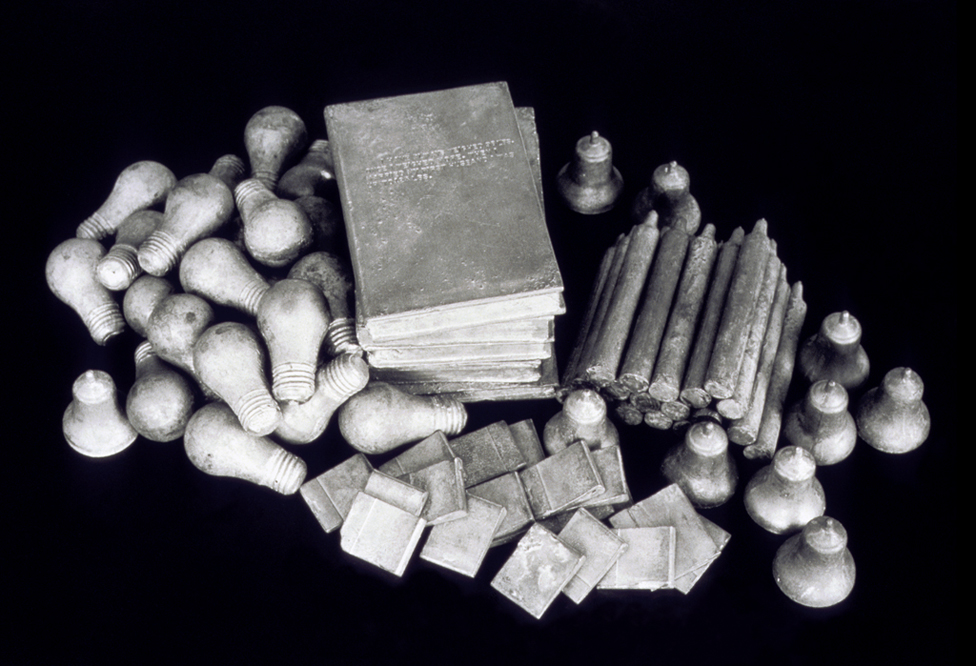
Liz Magor, “Dorothy, A Resemblance,” 1980-81. Collection of the National Gallery of Canada. Courtesy Susan Hobbs Gallery.
Projects like these signal a move on the part of Canadian artists toward working with sculpture as a material index. The objects arranged to form the works, the materials from which they are made, the means by which they are configured – all point to other non-sculptural phenomena. Carr-Harris’s chopped Victorian furniture and text gesture to imperialism and education; Magor’s use of weights allow lead to stand in for a female body; McKeough’s building and tearing-down of model homes echoes, in fast-forward, how neighborhoods are established and discarded. The familiarity of the appropriated ephemera (slide projector, table leg, light bulb, bungalow) presses hard against their treatment. When pulled from daily life and reformulated within the gallery, they might still remind us of home, but their sober materiality filters such memories through a dream-screen. The resulting works are home-like, but not truly at home – they are, in a word, unheimlich.
By contrast, the New Hoser Aesthetics is firmly entrenched in its own sense of place, and the type of belonging that exercises itself geographically. Here, one finds the textures of the basement workshop, the garage, the cottage, where language is disarmingly, unapologetically vernacular. Though it owes much to middleclass childhood, the NHA isn’t exactly nostalgia, nor a nationalistic celebration on the part of the artists. The NHA doesn’t promote the well-worn contexts it proposes, but instead undermines them, smuggling questions of collective belonging and institutional polish through the comfort of the familiar.
The disarming reference to a familial everyday is referenced by both the approach and the result evinced in Cedric Bomford‘s collaborative work with family members Jim and Nathan Bomford. For How Soon is Now (2009), the trio erected The Office of Special Plans, a two-level apparatus made of reclaimed wood, inside the Vancouver Art Gallery. Like Make It Flat, The Office of Special Plans suggests an arena – an oval circuit into which visitors can project a hypothetical performance. Its surfaces, however, and the means of its construction, are suggestive of a complex, sophisticated tree fort (the better to emphasize the father-son organization of the Bomfords’ collective). We are invited to enter the arena-fort, to navigate its walkways and use it as an observational tool for watching the movements of other visitors (and we can inhabit the work without that habitation being self-conscious).
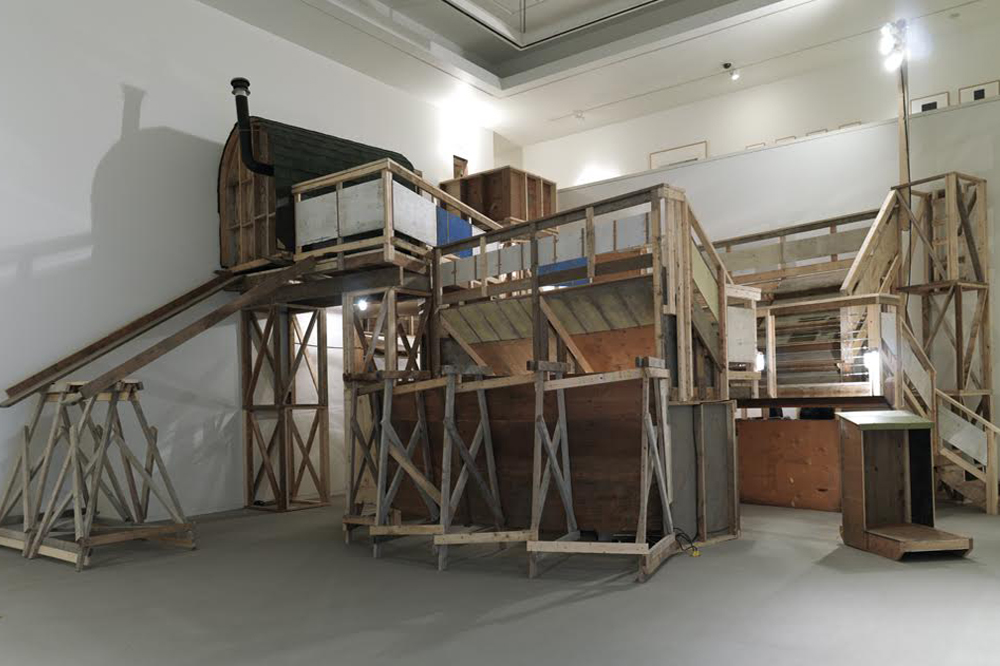
Cedric Bomford with Jim and Nathan Bomford, “The Office of Special Plans,” 2009. Image courtesy the artists.
Not far from the Bomfords in the Vancouver Art Gallery’s survey of young regional artists was an installation by Instant Coffee (the longest-running of the collectives mentioned here, and therefore, in some sense, the ur-Hosers). But a different and more recent Instant Coffee exhibition, Take the Easy Way (2013), is more relevant. Even at the level of its title, the work suggests something casual, as though Instant Coffee wants us to think of them as a loose confederacy of coolly carefree slackers. And yet rebellion is absent. Despite the fact that the color and pattern palette of the show – repeated houndstooth-reminiscent logo, vibrant neon lights, fuchsia cut-log stools – seems borrowed almost directly from Don Cherry’s wardrobe, their work is closer to high-school dance than punk-rock riot. Instant Coffee’s treatment of texture, material, surface, and visual language makes a tentative invitation to sympathy. Before long, a curious viewer is liable to see that the noise of apathy is really just insecurity’s disguise – like pop music, it assures us that our anxieties are not ours alone.
Take the Easy Way’s teenage flavor grows more directly from what Roland Barthes might have referred to as “Canadianicity” than from a specific national art history. Canada’s own national adolescence is in some sense at an end, no longer under the full sway and protection of Mother Britain, nor defining itself purely as an escapee from the shadow of its Big Brother Sam. An alternative explanation might be a Marxist one. The proliferation of postsecondary accreditation – especially the always-impractical art school – and the likelihood that its participants have relatively educated parents produces a generation of artists raised in suburbia (televisually, if not geographically). And the trick to surviving an adolescence in suburbia is to adopt a slacker’s apathy, the better to disguise one’s vulnerabilities.
Set against a broader art historical backdrop, the New Hoser Aesthetics strikes a bargain between an affable postmodernism and a conciliatory modernism. Satisfied that post-industrial materials and images are messy, disjointed things, these collectives round down the edges – physical and critical – sanding plywood for the benefit of a participatory individual, but wishing, secretly, for a whiff of the grand, transcendent moment of unity promised by the modern. It’s a Faustian gambit that plays both sides against the middle, but without any fatal reckoning. The NHA relishes in the material on the one hand and the social on the other. It represents an approach to experience-delivery alongside a clear philosophical underpinning: the idea that accessibility – vernacular, ordinary, familiar – matters, that you shouldn’t have to know all the tricks to enjoy the show, and that an invitation to an unfolding is better than an explanation that flattens. Under the circumstances, it’s as Canadian as possible.



















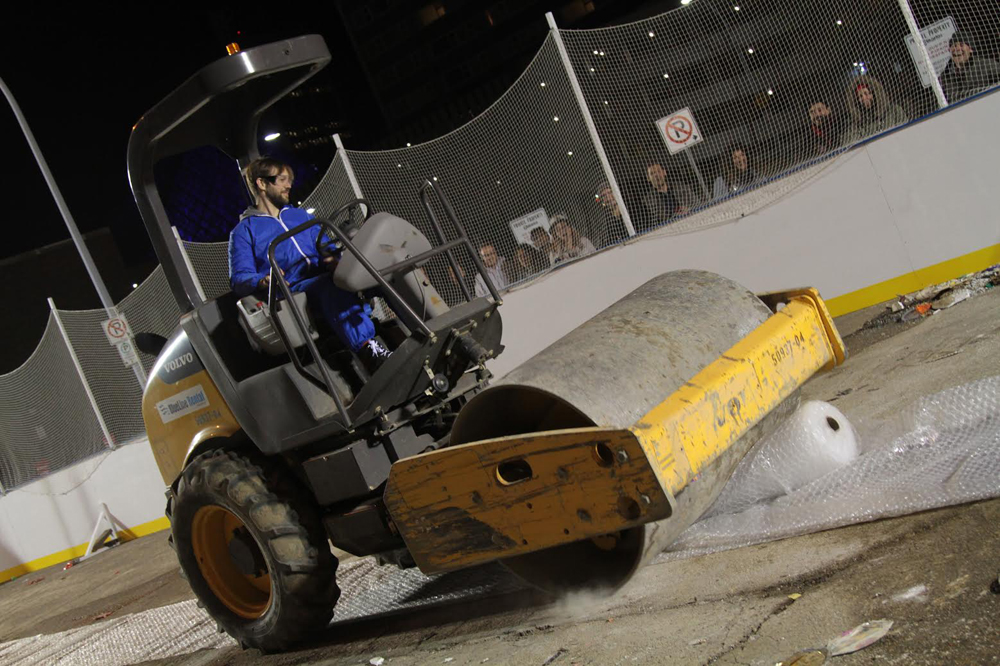

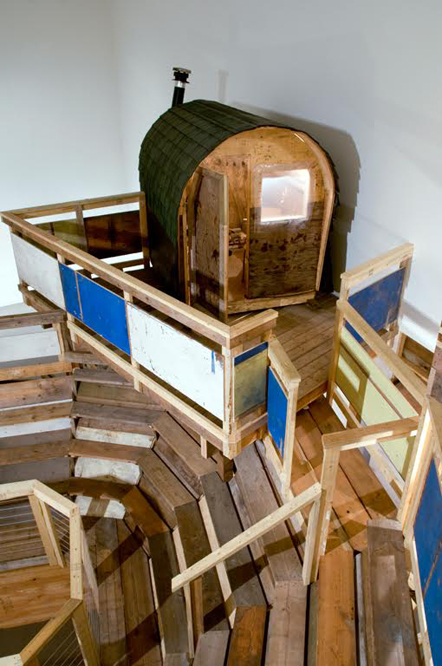


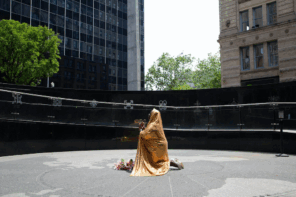
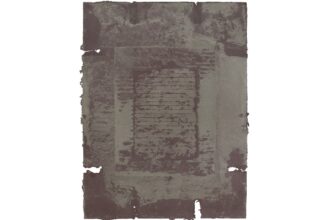
The art we deserve v.s. the art we need. This article is another premonition into the changing presence and perceived purpose of Canadian art. Let’s hope ‘Canadian’ Art doesn’t become an oxymoron.